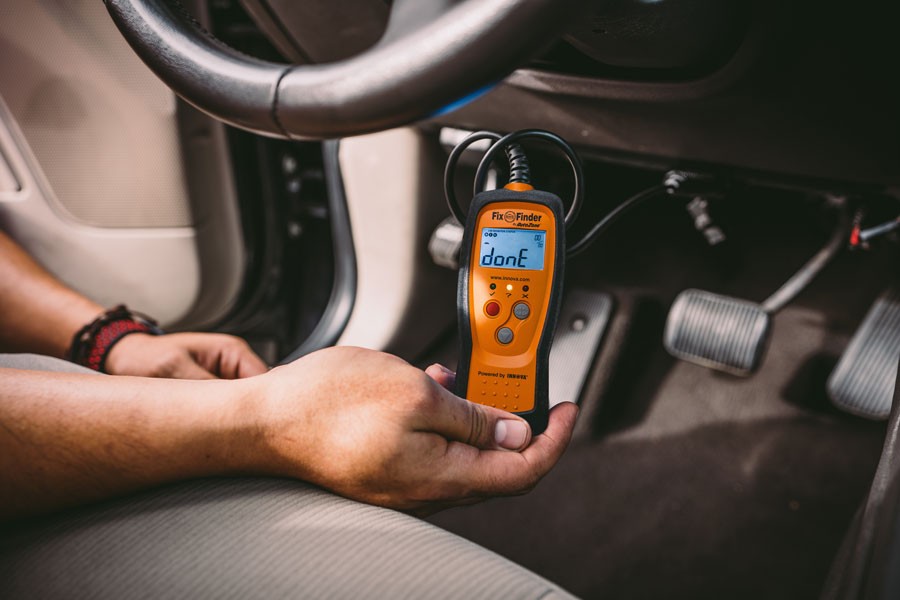Connecting and interpreting data from an OBDII scan tool can seem daunting. This guide provides a clear, step-by-step approach on how to use an OBDII scanner, understand its functions, and decipher the codes it retrieves. Understanding your car’s health starts with knowing how to use this essential tool.
Locating and Connecting Your OBDII Scan Tool
The OBDII port, a 16-pin trapezoidal connector, is typically located under the driver’s side dashboard. However, it can sometimes be found in the center console or under the passenger side dash. Connecting the scanner is straightforward: align the connector and firmly push it into the port.
The correct connection sequence is:
- Ignition Off: Ensure your car’s ignition is switched off before starting.
- Connect Scanner: Plug the scan tool into the OBDII port.
- Ignition On: Turn the ignition to the ‘on’ position without starting the engine. This powers the scan tool.
- Boot Sequence: Allow the scan tool to complete its startup process.
The scan tool may prompt you for additional information, such as the vehicle identification number (VIN) or engine size. Follow the on-screen instructions.
 OBD-II scanner plugged into port under dash
OBD-II scanner plugged into port under dash
Navigating the OBDII Scanner Menu
Once booted, the scan tool displays a menu with various options. These options can range from basic code reading to advanced diagnostics, depending on the scan tool model. Common functions include:
- Read Codes: Displays Diagnostic Trouble Codes (DTCs), often with brief descriptions of the fault.
- Erase Codes: Clears stored DTCs from the vehicle’s computer. Always confirm before erasing.
- Live Data: Provides real-time sensor readings, allowing you to monitor various parameters.
- Freeze Frame: Captures vehicle data at the moment a DTC was set.
- Vehicle Info: Displays vehicle-specific information, such as VIN and engine size.
- I/M Readiness: Indicates readiness for emissions and smog testing.
Use the buttons on the scanner to navigate the menu, select options, and return to previous screens. Even Bluetooth or Wi-Fi enabled scanners, controlled via smartphone, will have corresponding on-screen controls.
Understanding OBDII Trouble Codes
When you select “Read Codes,” the scanner displays a code in the format of one letter followed by four numbers (e.g., P0301).
The letter signifies the system:
- P: Powertrain (engine, transmission, emissions, fuel)
- B: Body (airbags, interior systems)
- C: Chassis (suspension, steering)
- U: Network communication
The first number indicates if the code is generic (0) or manufacturer-specific (1). The remaining digits pinpoint the specific system and fault. For instance, the third digit might represent:
- 1 or 2: Fuel and air metering
- 3: Ignition system or misfire
- 4: Auxiliary emission controls
- 5: Vehicle speed/idle control
- 7, 8, or 9: Transmission
Our example, P0301, signifies a generic powertrain code related to the ignition system, specifically a cylinder #1 misfire.
Leveraging Your OBDII Scanner for Savings
An OBDII scanner empowers you to:
- Diagnose Issues: Identify potential problems indicated by a Check Engine light or performance issues.
- Prepare for Smog Checks: Determine if your vehicle is ready for emissions testing through the I/M Readiness function.
- DIY Repairs: Diagnose and fix simple issues yourself, saving on diagnostic and repair costs. For example, a P0138 code indicates a faulty oxygen sensor, a relatively easy DIY replacement.
By understanding how to use your OBDII scan tool, you can gain valuable insights into your vehicle’s health, potentially saving time and money on repairs.
FAQ: Using an OBDII Scan Tool
How do you use an OBDII scanner?
Connect the scanner to the OBDII port, turn the ignition on, and follow the on-screen prompts.
Does the car have to be running to use an OBDII scanner?
Usually, no. The ignition ‘on’ position is sufficient for reading codes.
How do I read my OBDII scanner results?
Select “Read Codes” and note the displayed DTCs. Decipher the codes using the letter and number system outlined above. Online resources provide detailed code definitions.
Can I connect the OBDII scanner while the car is running?
While possible, it’s not recommended. It’s best to cycle the ignition off and on to initiate the scan.
